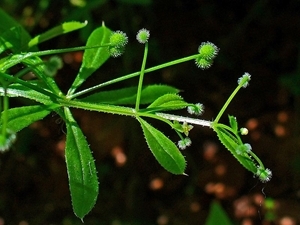Cleavers (Galium aparine)
 When a plant has earned itself around 80 colloquial names, you can bet your bottom dollar that it somehow plays a significant role in the countryside! Perhaps the most commonly used of these country names is goosegrass, however catch-weed, clites, hedge-burs, herriff, scratch, stick-a-back and in Scotland, sticky willy, are all regularly used names for this arable plant.
When a plant has earned itself around 80 colloquial names, you can bet your bottom dollar that it somehow plays a significant role in the countryside! Perhaps the most commonly used of these country names is goosegrass, however catch-weed, clites, hedge-burs, herriff, scratch, stick-a-back and in Scotland, sticky willy, are all regularly used names for this arable plant.
I’m sure that as kids we have all thrown some of this “sticky” plant onto the backs of grown-ups and run off laughing! It is in fact not sticky, but is covered in lots and lots of tiny little hooks, which the seeds in particular use to catch onto a passing animal or human, to get themselves transported to another part of the garden or farm.
Cleavers can be found right across the country, but prefer moisture retentive soils with high fertility and so feel very at home amongst our farm crops or vegetable patch. In fact trials have shown that the cleaver plant is more responsive to nitrogen, growing larger and producing more seed, than the farmer’s cereal crop that it was intended for! Unbelievably, this annual plant can germinate in the autumn and by using this added fertility, can grow up to a length of three metres by the following harvest.
Cleavers have an amazing ability to grow and fill any available space, which means that they soon compete with the crop, using up fertiliser, taking up sunlight and moisture, and eventually growing over the top of the cereal, making harvest much more difficult. In fact, when compared to other weeds that farmers have to contend with, just one cleaver per square metre will reduce yield by as much as three wild oats or 14 black-grass plants. It is 12 times more competitive than the next nearest broad-leaved weed, the poppy.
It has been shown that around 500 cleavers per square metre can halve a cereal crop’s yield, so you can start to see why farmers despise this plant so much. But that sounds like a very high infestation – surely that is a rare occurrence? Well, yes it is… but only because most farmers spray a weed-killer each year to kill them off!
Each cleaver plant can produce up to 500 seeds, so you only need 150 plants across a hectare (2 ½ acres) – which is not that many – for their numbers to rise to 25,000 the following year! Some farmers will plough the seeds deep under the soil if they have a problem, however, they need to be careful not to plough them up to the surface again the following year, as cleaver seed can remain viable for up to three years!
So you have to give it to the good old cleaver: we have thrown everything in our armoury at it and yet it is still a very common and persistent plant within our arable crops.
It is not all bad though, as the plant is well known for its diuretic benefits and for treating common conditions that require overall cleansing of the body. It is interesting that many animals seem to know this, as horses, sheep, pigs, chickens and of course geese (hence the name “goosegrass”) will often eat large quantities of this plant. Dogs too will sometimes eat it voraciously when a little off colour.
Maybe this is another little connection with the world around us that we humans have lost, yet animals retain?
Peter Thompson
Advisory
Read more from Peter Thompson at the Fresh from the Field blog.
Image © H. Zell, used under the terms of the Creative Commons licence.

Download Peter Thompson's essential 26-page book, featuring beautiful photography and detailed profiles of Britain's wildlife
Download FREE >